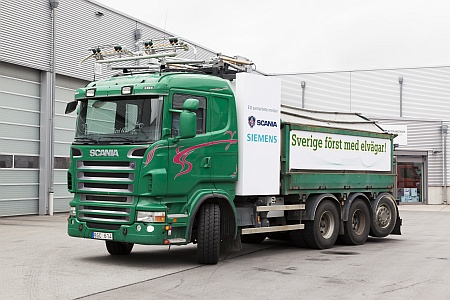Electric technology from Europe could transform U.S. trucking
With an abundant supply of natural gas, many U.S. trucking companies are looking at alternative fuels to power their trucks.
Liquefied Natural Gas (LNG), Liquefied Petroleum Gas (LPG) and biodiesel fuels made from corn, soybeans and other natural oils or animal fats are the most popular.
Another contender in the alternative fuels race is electricity.
FedEx and UPS are experimenting with all-electric vans in urban applications. These vans already are used in Europe. The U.S. market is still leery of all-electric vehicles, citing a relatively short range. However, the absence of fossil fuels and no emissions are making electric vehicles a viable option – particularly in smog-plagued markets such as Los Angeles and Houston.
Current experiments in Germany and California with another type of electric truck could lead to a radically new way for trucks as heavy as Class 8 to move freight in the United States.
Siemens, a longtime leader in railroad technology, is rethinking many of its proven rail concepts with an eye toward a highly efficient low-emissions commercial vehicle.
Siemens believes its sophisticated eHighway Project has the potential to succeed in what would be dedicated eHighway corridors in the United States.
At the heart of the concept is a diesel-electric hybrid truck. Unlike existing hybrid trucks in the U.S., this vehicle uses a constant-state diesel engine to drive a high torque-output electric motor – the same principle used to drive diesel-electric locomotives around the world.
In this mode, the Siemens hybrid drive system allows the truck to behave much like a conventional diesel truck, allowing the driver to maneuver on freeways and in urban settings as with a standard truck.
The benefit comes when the vehicle pulls into a dedicated “eHighway” lane that features overhead electrical lines powered by substations. The technology is common on trains in some European and Asian cities.
Once the truck is in an eHighway lane, a monitoring sensor in the truck’s nose detects the overhead power lines and automatically deploys a prong-shaped wand, called a pantograph. This acts as a conduit for the electrical power to flow to the electric motor.
Holger Sommer, eHighway project manager for Siemens, says the company decided from the outset that its concept would have to share eHighway lanes with conventional truck traffic. That’s partly because building exclusive electric truck lanes would be too expensive.
The pantograph not only moves up and down to make connection with the power lines, it also can move side-to-side to maintain contact and counteract normal steering input from the driver. Most importantly, the system is highly flexible. The driver also retains full control of all braking functions.
Any kinetic energy generated by a truck connected to the wires is put back into the grid automatically, where it could be used by other trucks.
If the sensor in the truck’s nose is not functioning, the driver can disengage the system manually with the push of a button.
Since the vehicle essentially is an electric truck with a constant-rate diesel engine, it can produce immediate high torque outputs without fuel consumption spikes. Lower-displacement diesel engines power the trucks and run continuously in their most efficient modes, drastically reducing fuel costs and dramatically cutting vehicle emissions, Sommer says.
Siemens has been testing the system extensively in Europe with modified Mercedes-Benz Actros trucks. Preliminary work has begun on building lanes in California to test the system for use in the United States.
The plan is to develop a one-mile stretch near the Port of Long Beach. The cost is $14 million, for which the California Air Resources Board is seeking funding. In addition to validating the eHighway concept in real-world conditions, the tests also will seek to determine vehicle and infrastructure costs.
Siemens stresses that the overall infrastructure impact in terms of investment and construction is relatively minimal, and that the system can be installed easily on existing roads.
“When most people think of vehicle emissions, they assume cars do most of the damage, but it’s actually commercial trucks that are largely to blame,” said Daryl Dulaney, U.S CEO of Siemens Infrastructure and Cities. “Freight transportation on U.S. roadways is expected to double by 2050, while global oil resources continue to deplete. And by 2030, carbon dioxide emissions are forecasted to jump 30 percent due to freight transport alone.”






